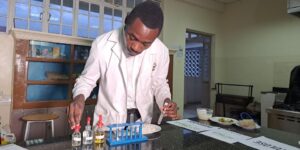Ever thought of eating ugali made from grass? Well, a team of students from Kabarak University have come up with an innovative idea to fight hunger using grass.
The students convert grass into edible starch flour that can be used to make ugali and porridge.
They believe that this will help the entire world to save the lives of people struck by hunger.
Faith Wandia, 24, a Business Administration (Finance) Master’s student who is the brain behind the project, says she came up with the idea two years ago.
She later incorporated three other students; Bahati Innocent, a Clinical Medicine student, Salome Njeri (Economics), and Edgar Ruto (Computer Science). Together they embarked on research and were able to break its code this year.

Ms Wandia told Newszetu that the increase in the price of maize flour in the country forced them to come up with a solution. They ended up with a project of converting non-food plant material into food.
She said they opted to venture into converting cellulose contained in grass into starch that is good for human consumption.
“About 9 million people die of hunger, 3.1 million are children. This means that 24,000 people are dying daily and 1,000 per hour and about 10 per cent of the world’s population go to bed hungry. In Kenya, 17 per cent of the total population live below the poverty line,” she said
“Last year, maize flour used to retail between Sh40 to Sh55 per kilogram, and it shot up this year to Sh90 up to Sh120 per kg. As innovators, we decided to come up with a project that would make food affordable and save people from dying of hunger,” she added.
Ms Wandia says they opted for grass which grows on 50 to 60 per cent of the total surface area of the earth. They settled on drought-resistant Bermuda grass and Ryegrass, which take only two months to grow.
After harvesting grass, the innovators wash it to remove contamination, dry it and grind it into powder (cellulose powder) before adding enzymes to break down the cellulose into starch.

“Grass is in the same family as maize therefore the starch is identical. At first, we were doing trial and error to see what would work. Sometimes, we ended up having glucose instead of starch and we had to start again. The cost of purchasing the enzymes and shipping was high,” she said.
Ms Wandia said that their goal is to reduce the number of people going to bed hungry from 10 per cent (900 million) to 3 per cent (70 million) by 2030. They also want to see a drop in deaths from hunger per year by 65 per cent by 2030.
“When I started this project, I had goals that I wanted to achieve. I am excited because I know this product will save lives,” she said.
According to Innocent, human beings cannot digest grass because they don’t have the enzyme in the gastrointestinal tract to break down the cellulose in the grass.
He said they are using a blender to grind the grass into powder and later add an enzyme to break down the cellulose into starch.
He said that at the laboratory they have necessary the temperature, pressure, and conditions for the reaction to occur after adding the enzymes which convert it to amylose, a starch that is similar to the one found in maize.
He said that once the reaction is complete, the final product has to pass the iodine test to ascertain that it is starch.
“When Wandia told me about the project I didn’t think it was something viable. I laughed it off but I later sat down and reassessed it,” he said.

“We approached our lecturers and through their guidance, we have solved the puzzle. We are now waiting for a certificate from the Kenya Bureau of Standards to clear the product as fit for human consumption before we can begin large-scale production,” he added.
Mr Wilson Balongo, the Innovation and Business Incubation Coordinator at the institution said that the innovation will promote grass farming, help solve the unemployment in the country and develop the county’s economy.
He said that as an institution, they have already started the process of patenting the project at the Kenya Industrial Property Institute (KIPI) to protect industrial intellectual property rights.
“We urge other innovators and friends or partners who are interested in innovation, to join us. We will accept any kind of support. So far, the university has come in handy to provide this platform for our innovators,” he said.
This innovation comes at a time after the government lifted the ban on Genetically Modified Organisms (GMO).
“Our product is not genetically modified organisms but simply a chemical that has been transformed from one form to another. Just like when you eat beans, the body converts them into amino acids. These amino acids are not GMOs, they are just transformed from one chemical form to another” said Mr Innocent.
Credit: Source link